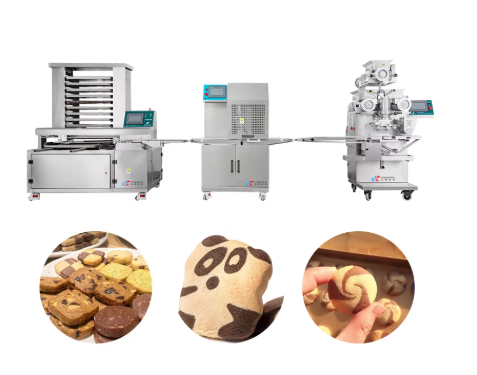Enhanced Production Efficiency Through Automation
Reducing Labor Costs with Automated Processes
Automating the cookie production process has a profound impact on reducing labor costs. By implementing automated systems, I've seen firsthand how the need for manual labor diminishes, thereby lowering overheads significantly.
Research supports this observation, indicating that automation could cut labor expenses by as much as 30%, especially in repetitive tasks like cookie dough mixing and portioning.
Additionally, automation minimizes human error, an often-overlooked benefit that results in cost savings associated with fewer product recalls and waste.
This efficiency not only enhances profitability but also allows businesses to reinvest resources into growth and innovation.
Accelerating Output for High-Volume Demands
For businesses looking to meet high-volume demands, fast and efficient machinery is indispensable.
Automated systems have the remarkable ability to produce thousands of cookies per hour, ensuring that large orders are fulfilled promptly.
Studies have shown that companies utilizing automated technology can boost production rates by over 40% compared to traditional methods.
This significant increase in output is crucial, especially when scaling operations to meet seasonal demand spikes.
Automation thereby ensures that production lines remain flexible and adaptable, meeting ever-evolving market requirements with ease.
By investing in such technology, businesses can not only improve efficiency but also maintain a competitive edge in the marketplace.
Consistent Quality and Uniform Product Output
Precision Dough Mixing for Perfect Texture
Automated mixing machines are essential for ensuring precision in dough mixing, which in turn results in a perfect cookie texture with each batch.
These machines harness advanced technologies like digital sensors that make real-time adjustments to mixing speeds, thereby refining the texture to the optimal level.
Consistent dough mixing is crucial because variations can lead to inconsistencies in cookie texture, ultimately affecting consumer satisfaction.
Using precise automated systems minimizes these risks, providing a reliable texture that consumers have come to expect, enhancing the overall product predictability and quality.
Portion Control for Uniform Cookie Sizes
Automated portioning systems are indispensable for achieving uniform cookie sizes, leading to consistent baking performance and customer satisfaction.
These systems reduce variance to less than 2 grams per cookie, a critical factor for branding and pricing strategies.
Ensuring that each cookie weighs the same improves baking efficiency because uniform sizes allow all cookies to bake evenly and simultaneously, optimizing energy use and cutting down on potential wastage.
This meticulous control over portioning not only strengthens brand integrity but also ensures that consumer expectations are met consistently, maintaining a strong reputation.
Temperature-Stable Baking for Even Results
Temperature-controlled baking systems play a pivotal role in guaranteeing even baking results, eliminating common issues like hot spots that can cause unevenly baked cookies.
Industry standards show that uneven baking can lead to a 15% increase in cookie wastage, often due to burning or undercooking.
Utilizing technology that guarantees temperature stability throughout the baking process enhances both flavor and texture profiles, fulfilling consumer expectations reliably with every production cycle.
By maintaining a stable temperature, the final product meets the high standards set by confectionery professionals, ensuring consumer satisfaction and reducing waste, thus maximizing production efficiency.
Cost Savings and Operational Optimization
Minimizing Ingredient Waste with Accurate Systems
One major advantage of using automated chocolate chip cookie-making machines is their ability to minimize ingredient waste, which in turn optimizes operations and achieves cost savings.
These machines are designed to accurately weigh and dispense ingredients, reducing material waste by nearly 10%.
Such precision not only cuts down on costs but also helps the environment by minimizing food waste.
Moreover, integrating these systems with data analytics can further optimize ingredient usage across numerous production runs, ensuring that each batch is as cost-effective as possible.
In an industry where margin edges are vital, reducing ingredient waste is a straightforward path to improving profitability.
Lowering Energy Consumption Through Efficient Design
Modern cookie-making machines are lauded for their energy-efficient designs, a feature that makes a significant impact on cost savings and operational sustainability.
These machines are typically equipped with technologies that reduce energy consumption by 20-30%, which is a considerable reduction in the energy expenses of a production line.
This not only lowers the operational costs but also aligns with increasing global sustainability initiatives, thereby enhancing brand value.
Investing in these energy-efficient machines can deliver a return on investment (ROI) within a span of 2-3 years, a period during which savings from reduced energy use and optimized production costs accumulate rapidly.
By embracing such technologies, businesses are not just cutting costs but also contributing to a more sustainable future.
Scalability for Growing Business Demands
High-Speed Production for Large Batches
High-speed production machines are pivotal for businesses aiming to swiftly adapt to growing market demands.
By enabling manufacturers to transition smoothly to larger batch sizes, these machines increase responsiveness to market changes by up to 50%, as suggested by recent industry studies.
This scalability ensures that manufacturers can meet large orders reliably, fostering positive relationships with customers and encouraging repeat business.
Embracing high-speed production capabilities can significantly bolster a company's reputation and market position, leading to long-term growth and success.
Flexible Machinery to Expand Market Reach
Flexible machinery offers a competitive edge by allowing manufacturers to adjust production for varying sizes and product variations, thus facilitating diversification.
This adaptability is crucial when entering new markets or responding to dynamic consumer preferences that demand innovative products.
Utilizing growth-driven machinery enables companies to expand effectively into niche markets, enhancing overall market reach and establishing a strong foothold in diverse sectors.
Such flexibility not only accommodates changes in demand but also supports strategic initiatives aimed at maximizing business potential.
Customization to Align with Consumer Trends
Interchangeable Molds for Diverse Shapes
Interchangeable molds are revolutionizing the cookie-making industry by allowing manufacturers to create an array of cookie shapes and designs that cater to diverse consumer tastes.
With growing demand for personalized products, these molds address consumer needs effectively.
They empower manufacturers to swiftly switch molds, thereby enhancing production efficiency while capturing seasonal and market-specific trends.
This flexibility appeals to consumers who seek unique shapes and aesthetics, particularly during festive seasons or special occasions.
Adapting Recipes for Dietary Preferences
In the modern food industry, automation plays a pivotal role in rapidly adjusting recipes to cater to various dietary preferences such as gluten-free or vegan options.
This adaptability is crucial for manufacturers aiming to stay ahead in the competitive market by meeting the rising consumer demand for health-conscious food products.
Recent research indicates that 38% of consumers actively look for products that align with their dietary requirements, underscoring the importance of recipe adaptability.
Manufacturers who can efficiently alter ingredients to meet these preferences are likely to gain a competitive edge and foster loyalty among health-conscious consumers.
FAQ
How does automation reduce labor costs in cookie production?
Automation significantly reduces labor costs by minimizing the need for manual labor, cutting expenses, and lowering overheads. This is especially impactful in repetitive tasks such as dough mixing and portioning.
How can automation improve production rates?
Automated systems can boost production rates by over 40% compared to traditional methods, thanks to their ability to handle high-volume demands efficiently.
What is the role of automated mixing machines in cookie production?
Automated mixing machines ensure precision in dough mixing, which results in consistent cookie texture, minimizing variations and enhancing overall product quality.
How do automated portioning systems benefit cookie production?
These systems achieve uniform cookie sizes by reducing variance, ensuring consistent baking performance, improving energy efficiency, and strengthening brand integrity.
How do temperature-controlled baking systems impact production efficiency?
Temperature-controlled systems eliminate issues like hot spots by ensuring even baking, reducing wastage, and boosting both flavor and texture profiles reliably.
What advantages do high-speed production machines offer?
High-speed production machines increase responsiveness to market demands, allowing manufacturers to swiftly transition to larger batch sizes and meet large orders reliably.
How does flexible machinery support strategic business initiatives?
Flexible machinery enables manufacturers to adjust production for diverse product variations and niche markets, enhancing market reach and maximizing business potential.
Table of Contents
- Enhanced Production Efficiency Through Automation
- Consistent Quality and Uniform Product Output
- Cost Savings and Operational Optimization
- Scalability for Growing Business Demands
- Customization to Align with Consumer Trends
-
FAQ
- How does automation reduce labor costs in cookie production?
- How can automation improve production rates?
- What is the role of automated mixing machines in cookie production?
- How do automated portioning systems benefit cookie production?
- How do temperature-controlled baking systems impact production efficiency?
- What advantages do high-speed production machines offer?
- How does flexible machinery support strategic business initiatives?






